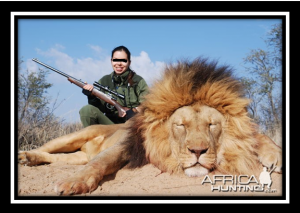News
Latest Lion Aid News
Lion trophy hunting - cost/benefit wins over ethics
Tuesday 16th April 2013
|
Big trophy, good price, no sweat The good news is that trophy hunting numbers (when comparing the last five year period 2002-2006 to the most recent five year period 2007-2011) have decreased for wild lions in Tanzania and Zimbabwe. The bad news is that “trophy” hunting of captive bred lions (“canned hunting”) in South Africa is on the increase. Here we explore some of the possible reasons for these trends. The decrease in wild lion hunting Overall, hunting of wild lions in Tanzania and Zimbabwe has dropped by an average of 45% over the past five years (Table 1). In their heyday Tanzania exported an average of 261 wild lions per year (1994-2003) and Zimbabwe an average of 139 wild lions per year (1990-1999). These two countries are still by far the biggest exporters of wild lion trophies, but there seems to be a waning interest among lion trophy hunters from the five major importing countries (Table 2). This drop can be explained as follows:
The increase in hunting of captive bred lions in South Africa can be explained as follows: a) Cost. As mentioned above, it is far cheaper to shoot a lion in South Africa than anywhere else as these are “put and take” hunts – the lion is supplied by a breeder, put in a fenced enclosure, and taken by the hunter. Female lions can be shot for about $4,000 - $5,000, and males start from about $15,000 (depending on the “quality” of the trophy – shooting an inbred white lion can cost $30,000).
Consequences Lion trophy hunting is touted by proponents as being a conservation measure – if lion hunting is stopped, large swathes of trophy hunting concessions in Tanzania, for example, will no longer be commercially viable. This will mean, according to the hunting operators, that all such hunting concessions will inevitably become havens for poachers and cattle. The newly appointed Director of Wildlife in Tanzania was motivated to write an Op-Ed article for the New York Times (Saving Lions by Killing Them), specifically quoting the need by Tanzania for income from lion trophy hunting. Sadly he got all his numbers wrong. He states that “an average of 200 lions are shot each year, generating about $1,960,000 in revenue”, likely salivating at the prospect. Actually, we can see that not only has lion hunting decreased by 44% over the past five years, but in 2011 a provisional total of only 57 lions were shot for an income to Government (trophy fees) of $456,000. Is it worth continuing lion hunting in Tanzania for the sake of 57 hunters going home with their trophies balanced against an uncertain future of the species exacerbated by excessive hunting offtake in the past? What is the future of lion hunting in Tanzania now that bargain basement hunting is available in South Africa? Also, what does this say about all the “hunter-conservationists” we read so much about? They supposedly shoot lions to benefit the species by spending lots of money to employ people and benefit communities, build schools and clinics, and put funds in Government coffers to be used for wildlife protection. But if they are defecting at a great rate from such high moral stances to shoot captive raised lions in South Africa, how serious about conservation were they in the first place? It is beginning to look like all they cared about was a lion trophy by any means or standards - underage, lured from a protected area, or captive-raised? Picture credit: http://bit.ly/YOsDBO
Table 2: Change in export numbers from Tanzania, Zimbabwe and South Africa from the five year period 2002-2006 to the most recent five year period 2007-2011 to the listed importing countries.
Please support our work if you can to conserve the remaining fragile lion populations. Thank you. Tags: lions, canned hunting, South Africa, trophy hunting, Tanzania, Zimbabwe, Categories: canned hunting/Captive breeding, Trophy Hunting |
Posted by Pieter Kat at 17:13
No comments have been posted yet.
Add a new comment
Existing user
New user sign up




